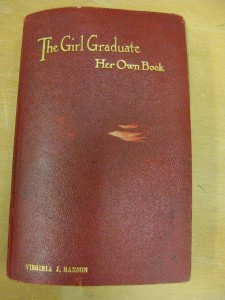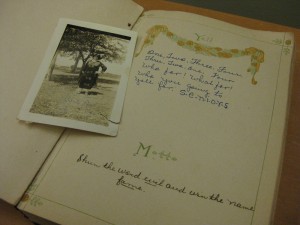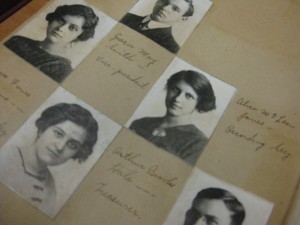Editor’s Note: This interview continues Monday’s conversation with Haley Aaron. See the first post here.
Have you used archival materials in your graduate work?
I have used a few of the collections available at the University of Alabama as a student at School of Library and Information Studies. In “Be True to Your School: Documenting High School Using Girl Graduate Journals,” I analyzed the girl graduate journal as a documentary form for an archives class. Girl graduate journals were mass-produced scrapbooks produced by book publishers that gained popularity in the 1920s. The journals contained pages with pre-fabricated headings and illustrations and provided room for high school seniors to collect letters and autographs from friends and teachers; include descriptions, tickets, and other ephemera from school events; and record information such as class mottos.
The Williams Collection contains three journals compiled by graduates of Alabama high schools: the Marie Brink memory book, Sidney Lanier High School 1922 (W.0017); the Virginia J. Hanson memory book, Birmingham High School 1912 (W.0018); and the Lola Higginbotham memory book, McAdory High School 1924 (W.0033). The scrapbook compiled by Virginia Hanson is particularly detailed; the Williams collection also contains other items created by Hanson, including a travel scrapbook describing a later trip Hanson took with three friends. It’s interesting to compare the high school scrapbook with the travel scrapbook.
How does your history training (Haley has a master’s degree in history from Georgia State University) contribute to your perspective on the material you handle in the archive?
I think my previous historical studies have given me a greater level of appreciation for the archival material I have been processing. At Georgia State, I was trained to think critically about the historical context of archival documents – asking questions about why items were created and how they fit into a larger narrative.
I drew extensively on archival materials while writing my thesis. Using archival collections allowed me to analyze the effectiveness of finding aids created by archivists and think critically about what made those access tools effective to me as a researcher. My historical training has also given me greater insight into how researchers may use the material I’m processing. My colleagues and professors used traditional and non-traditional resources in a variety of innovative ways. By speaking with them, I have a much better understanding of how historians approach and use archival materials.
As a researcher, I’ve always felt like historical research is like putting together an old jigsaw puzzle – some pieces may be missing and you may not have a very clear image for guidance. However, with some persistence and creativity, you can pull together a fairly complete picture using archival resources and fill in the gaps by reading and understanding the work of other historians. As an archivist, it’s my job to provide guidance to researchers piecing together the historical “puzzle” by clearly explaining what researchers can expect to find in a collection and explaining what gaps may still exist.
Congratulations in advance for receiving your master’s degree from the School of Library and Information Studies this December. Tell us about your next step.
Thanks! I am very excited to start my first full-time archival job in January. I will be working as a Manuscripts Archivist at the Alabama Department of Archives and History in Montgomery.
My work at the state archive will be similar to the work I have completed at the Williams Collection; I will be responsible for processing manuscripts collections and creating finding aids. I feel that my experiences as a student employee at the University of Alabama have opened doors in Montgomery; when I interviewed for the position, the interviewers spoke highly of my processing and inventory experience, which I gained by working on campus. The theoretical experience I gained in the classroom as a SLIS student was also essential. I am so thankful for the opportunities that my time at The University of Alabama has afforded me; I am especially grateful for the advice and support of the faculty and staff at the School of Library and Information Sciences and the Division of Special Collections.
As a native Alabamian, I feel honored to play a role in preserving and providing access to collections documenting the rich history of the state. I also feel blessed to start my career at the institution where I first found my calling – that high school visit to the archive really made a lasting impact!




